
The MuleSoft Anypoint integration platform is a unified platform that offers a holistic approach to API design and development. MuleSoft supports almost 300 connectors to databases, SaaS platforms, storage resources, and network services.
- Introduction to MuleSoft Anypoint
- What is the Anypoint platform and how it is useful?
- What are the key components of the Mulesoft Platform?
- What are the capabilities of APIs?
- What are the benefits of the Anypoint platform?
- What is the Mule Runtime engine?
- Why do we use mulesoft?
- Mule ESB (Enterprise Service Bus)
- What is the Design Centre in Anypoint platform?
- Conclusion
- With the development of this technological world, humans have developed highly advanced computer systems that can make their daily work easier with the help of various applications. Currently, there are billions of applications running across our tech ecosystem that make our personal and professional lives easier than ever.
- However, we are fully aware that one application cannot meet the needs and requirements of every function. This is where you need an API (Application Programming Interface) to connect multiple applications to each other. For example, Google Location is being used in your local food delivery application.
- Mulesoft is originally a software company based in California that focuses on developing integration software to connect data, devices and applications. The company began its services in 2006 as a middleware and messaging platform, but later introduced its revolutionary AnyPoint platform for product integration. The platform helps in integrating legacy systems, on-premises software, software as a service (SaaS) and many more.
Introduction to MuleSoft Anypoint:
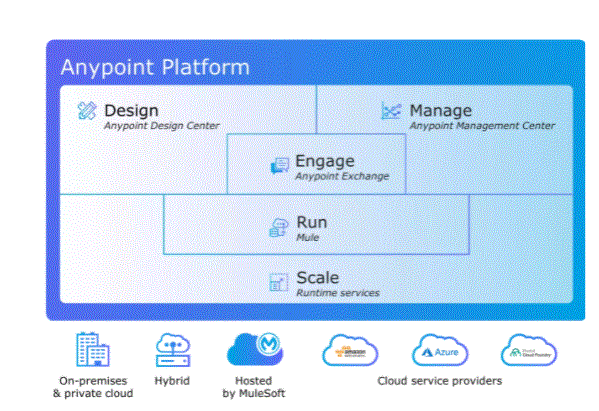
What is the Anypoint platform and how it is useful?
The Anypoint platform offered by Mulesoft is one of the leading enterprise platforms for the design and construction of application networks, APIs, and integrations. Mulesoft does all its operations on Mule, which is a lightweight ESB (Enterprise Bus Solution) and integration framework. Any Point can help you do almost everything you want on API and integration applications. In simple words, you can perform various operations on mule flows and applications with the help of Anypoint.
The Anypoint platform powered by the Mulesoft ecosystem comes with various components that can help you play around with the API. Please have a look at the following points given below:
Anypoint Studio: This is an Eclipse-based graphical development environment for running, testing, and designing Mule Flow.
Anypoint Design Centre: It helps you to design and develop APIs under Mulesoft Anypoint.
Anypoint Exchange: It is basically a library for API providers, through which they can share assets, templates and APIs.
Anypoint Management Centre: This is a centralised web interface for monitoring, managing and analysing integrations and APIs.
Anypoint Enterprise Security: This is a security-related feature suite for secure transactions and access to Mule applications.
- Rapid API Design
- Connectable with any system
- Mapping your data
- Testing and Deployment of Applications
- Real-time collaborative prototyping
- Integrate easily
- Map API and Dependencies
- Proactive performance monitoring
- Personalise your monitoring
- Fast troubleshooting
- Scale and high availability
- Control access
- Organise and Filter APIs
- Stream and handle data automatically
- Map and convert any type of data and format
- Highly scalable and extensible architecture
- Can be connected to any system
- Raise the mule anywhere
- Flexible and highly available performance
- Control access to the database
- Use the desired universal transport or protocol method
- Connect systems up to 5x faster using prebuilt connectors
- Create reusable templates and connectors to accelerate development
- Authenticate your connector for its availability to each MuleSoft partner or customer
- Protect the information flow as it runs in batches or in real-time
- Mule runtime services
- Mule Runtime Services can be said to be a comprehensive suite of platform services providing reliability, scalability, enterprise-grade security and high-availability.
What are the key components of the Mulesoft Platform?
We have already seen the features that Mulesoft Anytime Platform provides for us to play like a pro with API and integration apps. Now, let’s take a look at the main components of the Mulesoft platform.
Anypoint Design Centre:
Anypoint Design Centre provides you with various development tools that make it extremely easy to create connectors, implement integration flows, and design APIs. It works as a complete product for designing and manufacturing APIs as well as integration at lightning speed. Anypoint Design Centre in Mule provides you with a syntax-aware web-based ecosystem for designing and documenting APIs. Its card-based visual interface allows you to perform various tasks such as transform data graphically, reuse connectors or APIs, or perform/schedule an action.
The additional benefits associated with Mulesoft Anytime Design Centre are:
Anypoint Management Centre:
Anypoint Management Centre is basically a unified web interface, which is used to manage all aspects of the platform such as SLAs, API users, underlying integration flows, traffic and many more. In simple words, we can say that it gives you fully centralised control and visibility over all your deployed APIs and applications. With its help, you can remotely monitor and provision applications on any platform. In addition, you will be able to monitor real-time performance and speed up problem detection using Anypoint Management Center.
Let us have a look at the following benefits associated with it:
Anypoint Exchange:
Anypoint Exchange can be termed as a collaboration hub for finding and using prefabricated, public and private reusable assets. In simple words, it is a platform that provides you a complete list of templates, APIs, examples and connectors. With its help, you can easily find and access properties built within the MuleSoft ecosystem. In addition, you can also add the desired property to a private tenant of Anypoint Exchange to share and collaborate on best internal practises.
Now let’s take a look at some of the benefits of using the Mule Runtime Engine:
Anypoint Connectors:
As defined by its name, Anypoint Connectors provides a lot of out-of-the-box tools and assets for fast connectivity. Apart from this, you also get many tools to develop yourself as per the requirements. With the help of Anypoint Connectors, you can easily connect prebuilt connectors to your desired endpoints and also create your own reusable connectors using Anypoint Connector DevKit.
Now, we would suggest you to please take a look at the benefits that come with it:
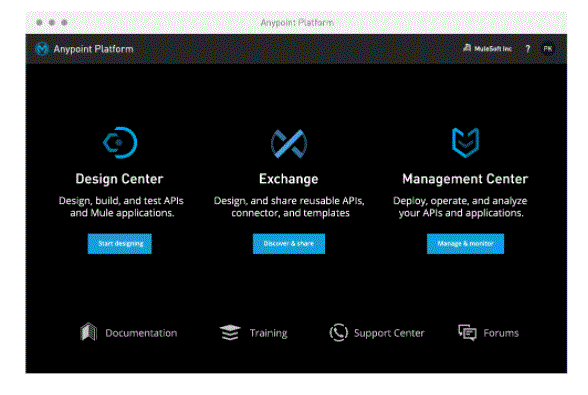
- The word ‘capability’ means power or ability to do something, therefore, the ability of an API to perform any task can be called its capability. Capability of an API is one of the most important things before designing it.
- Without knowing the capabilities of the API at an early stage, your API may not be able to deliver satisfactory performance. We can understand this more easily with the example of your body parts. Each of them has its own roles and responsibilities and the neurons in the human brain work as an API.
- Neurons in the form of APIs have complete information about the work of your hand and perform commands when needed. The same goes for your API and application. Before starting coding, there are some questions to be concerned about, such as who will be using the API?, Why would they want to use the API? What benefit will it provide them? Serious efforts.
- Answering these questions will automatically illuminate the capabilities of your API, as you will be in the right direction towards your users and their needs. When planning an API, it is very important to ensure that you are exclusively accounting for the needs of your developer. However, it is equally important to understand how your API resources work together.
- This action will automatically prevent you from having to rewrite the code every time you design or build your API. Therefore, we can only say that the capability of an API can be everything a developer ordered it to do, and every developer needs to plan it before designing an API.
What are the capabilities of APIs?
What are the benefits of the Anypoint platform?
MuleSoft Anypoint is undoubtedly a great platform for building or designing APIs. It offers a fascinating approach towards the Internet of Things (IoT). Being such a commendable digital product, there are many benefits associated with it that can help you integrate your applications with each other.
Some of the main benefits of the Anypoint platform are mentioned here, so we suggest you take a look at the following points mentioned below:
Separate workflow
The most impressive thing about Mulesoft Anypoint is that you can perform all the desired tasks without interrupting the current business process. You can easily connect legacy assets to SaaS technologies, reduce integration costs, and unlock legacy systems with it.
Increase productivity
Mulesoft Anytime gives you a great facility to create your own custom APIs which can ultimately increase the productivity of the developer. Furthermore, using these open technologies also reduces development time as they promote modularity, reusability and collaboration.
Easy management of resources
You get the great Anypoint Management Centre in the Mulesoft Anypoint platform, which is a great tool to manage all your assets in one place. The resolution time is also greatly reduced as you will be able to manage all your resources from a single pane of glass.
Amazing tool
Mulsoft Anypoint provides you with a range of tools by which you can rapidly accelerate value creation and innovation across the enterprise. These tools enable rapid testing, development and implementation of APIs. Mulesoft Anypoint is a one-stop solution for building all kinds of APIs.
Flexible architecture
Mulesoft Anypoint comes with a flexible architecture that evolves as your business grows. You will also be able to increase agility in your business with its highly advanced and responsive architecture.
Valuable services
You can create many happy customers by offering valuable services with the help of Mulesoft Anypoint platform. Furthermore, developing a competitive advantage by providing a high-end experience is also just a piece of cake by using Mulesoft Anypoint.
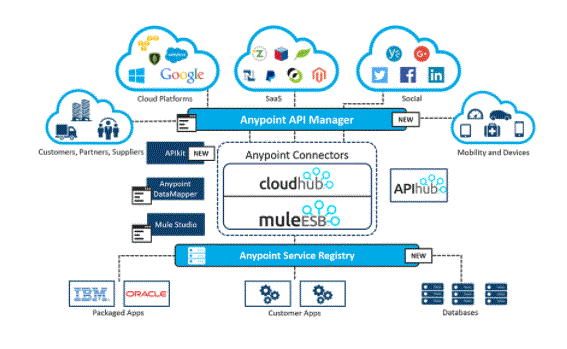
What is the Mule Runtime engine?
As we have already mentioned above, Mulesoft Runtime Engine is the only platform available to connect or integrate applications, devices and data with each other. Simply, we can say that the Mule Runtime Engine provides you an open architecture to handle every kind of integration challenge with ease. Let us take a look at the main components of the Mule Runtime engine, to give you a more in-depth understanding of it.
Custom business programs
It is basically used to collect all the necessary information about the flow and the message processor, which handles your business transactions. This information may include transaction errors, execution times, results and message payload information.
Dynamic evaluation
With the help of the dynamic evaluation component, you will be able to dynamically select a script instead of hard-coding it through the conversion message component. Scripts can include any number of common context variables such as attributes, versions, payloads, and messages. However, you are also allowed to add custom ones by offering a set of key-value pairs.
Flow reference
The Flow Reference component in Mulesoft helps to create a path or route between a Mule event and some other flow or sub-flow within the same Mule application. By doing this, you will be able to treat the entire contextual flow as a single component. The flow context divides the mule application into potentially reusable and discrete units.
Wood cutter
This component in Mulesoft helps to log essential information about your Mule application such as status notifications and error messages. It is one of the core components of Mulesoft and can help you with monitoring or debugging your Mule application. To execute this, you need to add a logger flow and you can easily configure it to log a specific string.
Parse template
The Parse Template component in Mulesoft is used to process a template, by which the result can be retrieved. A template can be defined as text with embedded mule expressions, which are evaluated and replaced with their appropriate result. You can either configure a template through an external file reference or embed it in the component itself.
Change message
Transform messages in Mulesoft are used to transform input data into a new format or output structure. This component allows you to write transformations explicitly in the DataWave language. Apart from this, you can also use the user interface to develop it indirectly through drag and drop functionality.
- MuleSoft provides the most widely used integration platform for connecting SaaS and enterprise applications in the cloud and on-premises. Back in 2018, MuleSoft was acquired by Salesforce primarily to accelerate the digital transformations of customers. MuleSoft’s integration platform not only enables data unlocking across legacy systems, cloud apps and devices, but also enables smarter and faster decision making, and provides a highly connected experience for end-users.
- MuleSoft’s Anypoint platform is now a part of the Salesforce Integration Cloud. In contrast, MuleSoft has a pre-built connector into Salesforce for seamless integration. MuleSoft provides many pre-built APIs for all types of applications and systems.
- By placing an API in front of your old legacy system, you immediately get a modern way of interacting with the system, without knowing how it operates. If all of your on-premises or cloud systems have an intermediary API, called a system API, that can understand the language of modern systems, they can communicate by exchanging data.
- All MuleSoft APIs are organised in a network and are assigned different roles. The more complex Process APIs are responsible for processing the extracted data and performing some logic, while the Experience APIs deal with formatting the data to be presented on various media devices such as desktop, mobile, apps, etc. The Anypoint platform is unique in its ability not only to manage and streamline API-led integrations, but also to develop and execute APIs.
why do we use mulesoft?
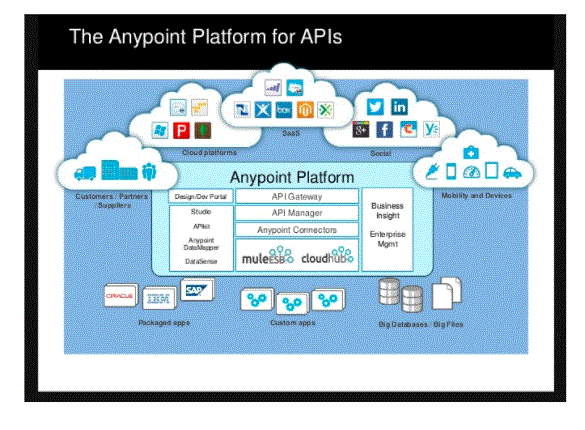
Mule ESB (Enterprise Service Bus):
Enterprise Service Bus (ESB) is basically an architecture. It is a set of rules and principles for integrating multiple applications on a bus-like infrastructure. The core concept of the ESB architecture is connecting different applications by placing a communication bus between them and then enabling each application to talk to this bus. This approach isolates systems, allowing them to communicate without dependency or knowledge of other participants. Mule, the AnyPoint platform’s runtime engine, is a flexible ESB solution that helps increase agility by implementing a simple, well-defined, “pluggable” system that scales well.
Orchestration and flow:
Orchestration is needed when there is a need to combine existing services to meet business needs. This involves opting for point-to-point integration in favour of chains of operations that can be reused or modified as the system or business requires changes. Flows enable new ways to organise service arbitration. For example, you can combine an arbitrary number of sources, routers, and components that work together to achieve implementation requirements. Flow enables you to organise new forms of data movement based on flow-specific routers. Orchestration allows you to create and reuse flows and component chains, chain multiple components together in a flow, and integrate sources or connectors anywhere in a flow.
- Anypoint Design Centre includes a web-based tool where MuleSoft developers design and build API specifications and components (API Designer). Once your API specification or piece is ready to be shared with the rest of the organisation, you publish it to Anypoint Exchange for testing and approval. This development approach is called spec-driven.
- Before moving to the API implementation phase, it is important to obtain ‘sign-offs’ from the business and other teams. They will test APIs returning mock results, provide initial feedback, and validate requirements. Anypoint Exchange is a virtual marketplace for sharing, finding and reusing APIs, connectors, templates, etc.
- The second part of the Design Centre, the Flow Designer, is used to build mule applications that connect systems. API-connectivity is an architectural method powered by MuleSoft for connecting data to applications via reusable APIs.
- This is a major change away from the infamous point-to-point integration. Using an API-led connectivity approach, you can build a flexible and scalable network of APIs. One of the top benefits of API-led connectivity is reusability; For new projects, you can reuse many existing assets and APIs to save time and effort.
- MuleSoft recognizes 3 types of APIs based on their role: System, Process, and Experience. System APIs are responsible for ‘talking’ directly to the back-end system. Their main role is to hide the complexity of the underlying systems.
- Process APIs merge and process data provided by one or more system APIs for a specific business purpose. For example, to deliver a 360 customer view, the process receives information from various systems. The data has to be merged and processed before it is passed to the Experience API.
- Experience APIs are complex APIs that combine information from multiple APIs but their role is to convey this information to a specific channel. By a channel, we mean a mobile app, your partner organisation for data-sharing, internal processes or even robots (RPAs).
What is the Design Centre in Anypoint platform?
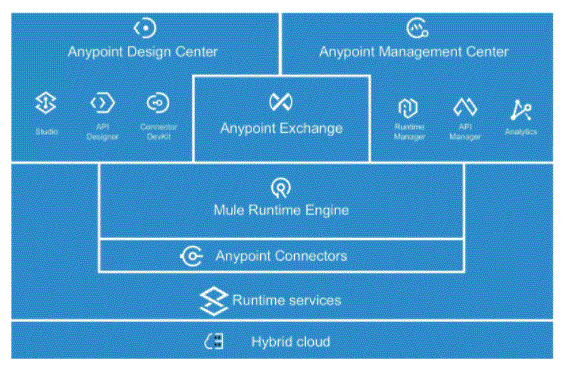
Conclusion:
In simple words, we can conclude that Mulesoft is quite good in terms of integration and its 6 main components make it a panacea for creating APIs. Its Anytime platform lets you play with APIs to make your development process easier than ever.In the rapidly growing technology of ‘IoT’, platforms like Mulesoft play a vital role in integrating different types of data and applications. There are many APIs focused on different types of roles, you can choose any of them and create a masterpiece for your business or high end software. How you can use it is up to you.





